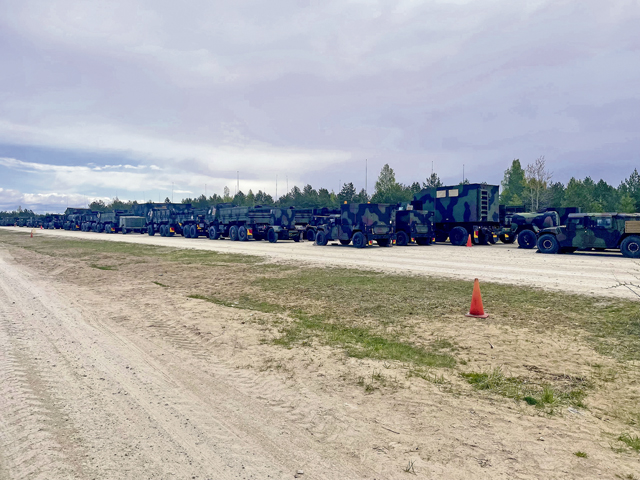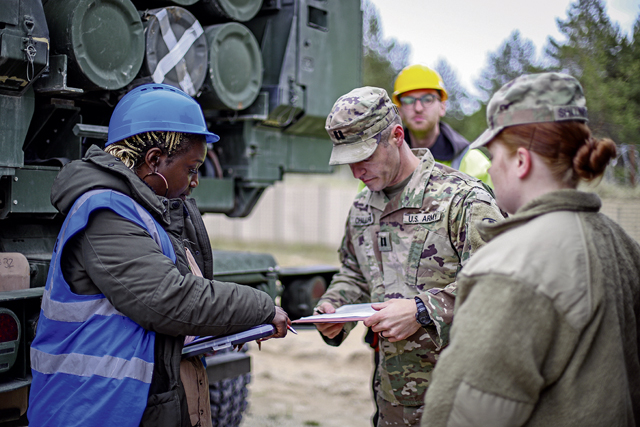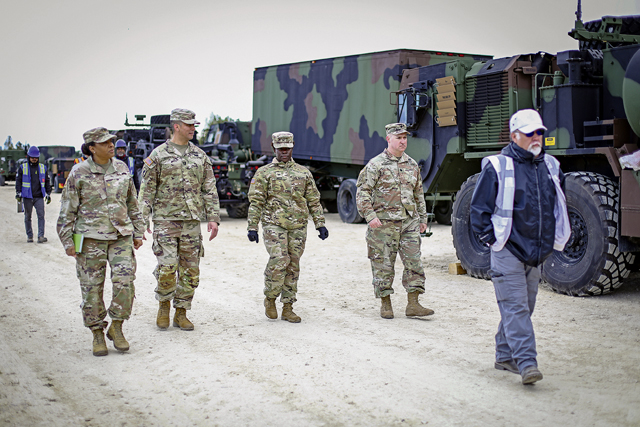
The 405th Army Field Support Battalion – Germany, 405th Army Field Support Brigade issues High Mobility Artillery Rocket Systems to 1st Battalion, 182nd Field Artillery Regiment from the Michigan National Guard here on May 6 in preparation for Defender 2023.
“Our mission here is to provide HIMARS and a battalion minus worth of equipment from our APS-2 site in Germany to the 1-182 FAR in order for them to conduct joint operations with partner nations,” said Maj. Sherita Young, support operations officer, 405th AFSBn – Germany. “This equipment is expected to depart the theater on or about May 26 and is strictly for the Defender exercise as they support operations with our partners in Estonia and beyond.”
Young, and her team of 44 Soldiers, Department of Defense Contractors and Civilians have been preparing for this mission here in Latvia since April 10th and the task was extraordinary for them this time around, due to the fast pace the equipment had to be set and mission capable for their Michigan artillerymen to inspect, gain accountability and deploy the equipment with success and on time. Typically the 405th AFSB is allotted at least six months to bring it back to full mission capability and prepare for distribution. With this dynamic mission, the battalion’s time was cut in half.

“The typical [equipment] build gives you six months to refit once we issue the equipment and bring it back to full mission capability,” said Young. “We were in a unique situation where we received this equipment back from another unit in January and we had to make a quick turn to have it ready in April, shipped and ready to go.”
A quick timeline did not inhibit standards and efficiency for the APS team. While the team in Germany had to move quickly to ensure the proper maintenance, shipment and protocols were in place for this fast-paced issue of over 340 pieces of equipment to 1-182 FAR was on time and ready for distribution.
Mobilizing all the way from Detroit, Capt. Ed Ohalloran, battalion logistics officer, 1-182 FAR was surprised at the level of efficiency and grateful for having the extra time necessary to plan future operations with his unit.
“This has been smooth,” said Ohalloran. “I’m thoroughly impressed. To go in here thinking it would take four days and it only took a day and a half has been mind-blowing. This gives us more time to set up and improve our TOC [Tactical Operations Center] operations on the other side and execute other missions. I’m very impressed.”

What is not commonly known about these Equipment Configuration and Handoff Areas is that it is mainly composed of civilian professionals. Out of the 44-member team at this site issuing HIMARS and equipment, only two of them are green suitors.
Capt. Roberto Rivera, ECHA officer in charge, 405th AFSBn – Germany, is one of the two Soldiers from his unit at the APS-2 issue site. Rivera plans and executes operations from start to finish and has done several of these as a logistician, but none like this one. He gives the credit to his civilian teammates and the host nation in Latvia.
“The DOD Contractors and Civilians play a vital role,” said Rivera. “In fact, this has been one of the best ECHA sites we’ve ran, and I attribute that to them and the Latvians. They’ve been very hospitable to us.”

This past year has been a historic one for the 405th AFSB and the capabilities they have brought to the warfighter and sustainment world. Their mantra is ‘Support The Warrior,’ and for them to continue to do that in an everchanging theater, investment is one of the many keys to their success.
“Use of APS-2 is for [a] wartime mission for a rapidly deploying unit,” said Young. “It is imperative that the Army continues to invest in keeping this equipment on hand ready. This is one thing we’ve learned this last year as it’s been utilized like it’s never been used before. There needs to be a definite continued investment in how we maintain and keep it up to date. That includes how it is stored, its facilities and infrastructure.”







